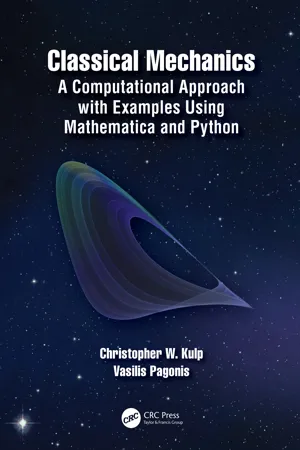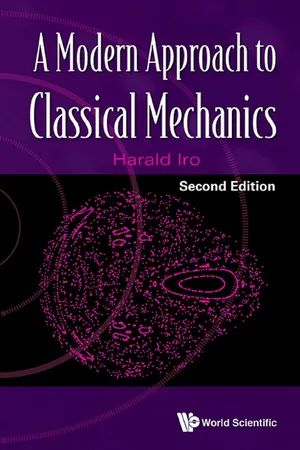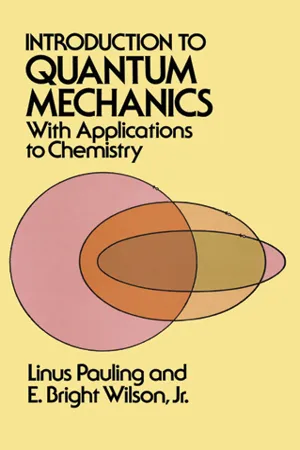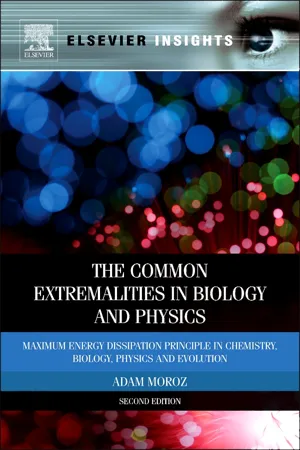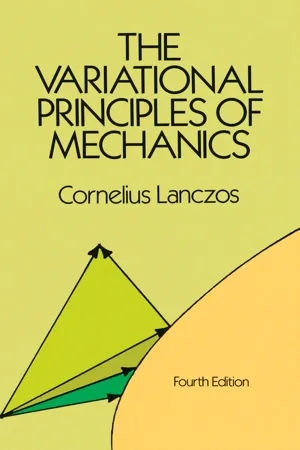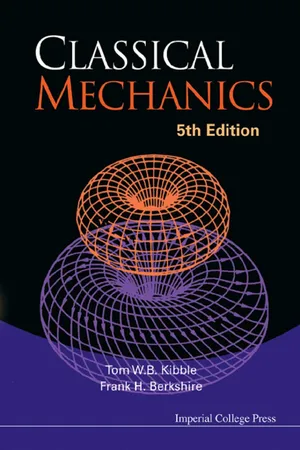Physics
Lagrangian Mechanics
Lagrangian mechanics is a reformulation of classical mechanics that describes the motion of particles and systems using a single function called the Lagrangian. It provides an alternative approach to Newton's laws and is particularly useful for solving complex problems in physics. The Lagrangian is defined as the difference between the kinetic and potential energies of a system.
Written by Perlego with AI-assistance
Related key terms
Related key terms
1 of 4
Related key terms
1 of 3
7 Key excerpts on "Lagrangian Mechanics"
- eBook - ePub
Classical Mechanics
A Computational Approach with Examples Using Mathematica and Python
- Christopher W. Kulp, Vasilis Pagonis(Authors)
- 2020(Publication Date)
- CRC Press(Publisher)
CHAPTER 8 Lagrangian and Hamiltonian Dynamics In this chapter, we will present an alternative way of formulating physics problems. This new method was first published by French-Italian mathematician Joseph-Louis Lagrange (1736–1813) in 1788 and is therefore called Lagrangian dynamics. Lagrange’s formulation uses a function called the Lagrangian, which is found using the particle’s energy. As we will see, a particle will move in such a way as to make the integral of the Lagrangian with respect to time stationary. The integral, called an action integral, is a functional (a mathematical formula that maps a function to a number). Hence, the particle’s path can be described using a function that is an extremum of a functional (the action integral). In the last chapter, we learned how to find the functions that are the extrema of a functional by using the Euler equation. In this chapter we will learn how the Euler equation can be used to find a system’s equation of motion. One advantage of the Lagrangian formulation is that it is the same, regardless of the coordinate system being used. Lagrangian dynamics uses the Euler equation to derive a particle’s equation of motion and the Euler equation takes the same form regardless of the coordinate system being used. As we saw in Chapter 3, Newton’s second law takes different forms depending on the coordinate system, because the formula for the acceleration depends on the coordinate system. Another advantage of Lagrangian dynamics is that it eliminates the need of knowing constraint forces. A bead constrained to move along a wire is a common example involving constraint forces. The force keeping the bead on the wire is often unknown, or very difficult to find - eBook - ePub
- Harald Iro(Author)
- 2015(Publication Date)
- WSPC(Publisher)
9Lagrangian Mechanics
At the end of the 18th century, an important stage in the development of classical mechanics was achieved. In 1788 Lagrange presented mechanics in a uniform, clear and very elegant manner in his “Mécanique analytique”. Lagrange’s book is the first comprehensive representation of analytical mechanics. It is an edifice of ideas: the building blocks are logical related to each other. The representation of physical processes by mathematical theories and models is unified and elegant. This “Analytical Mechanics” is a ‘phenomenal achievement in the economy of thought1 ’ (E. Mach, “The Science of Mechanics”).The treatment in this chapter differs from the historical development: Lagrange’s work is based on D’Alembert’s principle2 and on the concept of virtual displacements; we consider neither in this book. Instead, after a brief account of the calculus of variations, Lagrangian Mechanics is introduced by identifying Newton’s equation of motion with the Euler-Lagrange equations for the Lagrangian.9.1 Constrained motion
In many problems in classical mechanics, we are given not only the forces, but also certain constraints that the orbits must obey. For example, in the case of the pendulum, the mass must remain a constant distance away from the pivot point. One distinguishes various kinds of constraints. A constraint depending only on the position r(t) of the particle and on time t, i.e. of the formis called a holonomic constraint. (In the case of the pendulum, the holonomic constraint is r2 (t) − l2 = 0.) Constraints that cannot be written in this form, for example, those that- Contain velocities or differentials only of the radius vectors (e.g.: or,- Appear only as inequalities,are non-holonomic. Examples of systems with non-holonomic constraints include:- The motion of a particle restricted to the interior of a sphere, |r(t)| ≤ R;- A wheel (radius R) rolling on a surface. Here the constraint v = relates the angular velocity of the wheel to its linear velocity v - eBook - ePub
- Robert Weinstock(Author)
- 2012(Publication Date)
- Dover Publications(Publisher)
lagrangian —as6-2. Hamilton’s Principle. Lagrange Equations of Motion(a ) Although Newton’s laws of motion are the most fundamental mathematical description of mechanical phenomena in general, it best suits the purposes of our study to assume the validity of Hamilton’s principle as the physical law which describes the motion of any system of the type considered in 6-1 above. The principle of Hamilton reads:The actual motion of a system whose lagrangian isis such as to render the (Hamilton’s) integralwhere t 1 and t 2 are two arbitrary instants of time , an extremum withrespect to continuously twice-differentiable functions q 1 (t ), q 2 (t ), …,qN(t )for which qi(t 1 )and qi(t 2 ) are prescribed for all i = 1, 2, …, N . We accept Hamilton’s principle as applicable to the motion of any conservative system.Although it is in some places stated that Hamilton’s principle may be used to replace Newton’s laws of motion as the fundamental starting point for mechanical systems possessing a lagrangian, it should be realized that Newton’s laws are implicitly employed in the preceding paragraphs in at least two ways: (i) The definition of mass resides in Newton’s third law. (ii) In the tacit assumption that our system of coordinates is fixed relative to an inertial frame of reference, we make use of Newton’s first law, by means of which an inertial frame is defined.(b ) With the result (57 ) of 3-8(a ) we conclude from Hamilton’s principle that the generalized coordinates describing the motion of a system of particles must satisfy the set of Euler-Lagrange equationsThe equations (8 ), Lagrange’s equations of motion, constitute a set of N simultaneous second-order differential equations, whose solution yields the functions q 1 (t ), q 2 (t ), …,qN(t ). The 2N constants involved in the general solution of (8 ) are evaluated when the initial (t = 0, for example) values of all theqiand (i = 1, 2, …, N ) are given. Once the initial state of the system is thus prescribed, its future motion is described in detail by the functions obtained through the solution of (8 - Linus Pauling, E. Bright Wilson, E. Bright Wilson(Authors)
- 2012(Publication Date)
- Dover Publications(Publisher)
quadrupole moment of the system, and higher powers form higher moments. The rate of emission of radiant energy as a result of the change of quadrupole and higher moments of an atom or molecule is usually negligibly small in comparison with the rate of dipole emission, and in consequence dipole radiation alone is ordinarily discussed. Under some circumstances, however, as when the intensity of dipole radiation is zero and the presence of very weak radiation can be detected, the process of quadrupole emission is important.4. SUMMARY OF CHAPTER IThe purpose of this survey of classical mechanics is twofold: first, to indicate the path whereby the more general formulations of classical dynamics, such as the equations of motion of Lagrange and of Hamilton, have been developed from the original equations of Newton; and second, to illustrate the application of these methods to problems which are later discussed by quantum-mechanical methods.In carrying out the first purpose, we have discussed Newton's equations in Cartesian coordinates and then altered their form by the introduction of the kinetic and potential energies. By defining the Lagrangian function for the special case of Newtonian systems and introducing it into the equations of motion, Newton's equations were then thrown into the Lagrangian form. Following an introductory discussion of generalized coordinates, the proof of the general validity of the equations of motion in the Lagrangian form for any system of coordinates has been given; and it has also been pointed out that the Lagrangian form of the equations of motion, although we have derived it from the equations of Newton, is really more widely applicable than Newton's postulates, because by making a suitable choice of the Lagrangian function a very wide range of problems can be treated in this way.In the second section there has been derived a third form for the equations of motion, the Hamiltonian form, following the introduction of the concept of generalized momenta, and the relation between the Hamiltonian function and the energy has been discussed.In Section 3- eBook - ePub
The Common Extremalities in Biology and Physics
Maximum Energy Dissipation Principle in Chemistry, Biology, Physics and Evolution
- Adam Moroz(Author)
- 2011(Publication Date)
- Elsevier(Publisher)
Similar to mechanics, the relationships between the degrees of freedom described by the functions of field (wave function) can be obtained by the variational method on the basis of the ideology of the least action principle. Therefore, it is reasonable to remember the main points of its formulation for the purpose of finding out the penalty forming the sense of the Lagrange approach for the most frequently considered physical fields. It would in turn allow the analysis of the energetical penalty formation to be carried out, having connected it eventually with penalty formulation (i.e., the MED principle) in biology.So in the case of mechanics, the Lagrange function depends directly on coordinates, their derivatives, and time:(5.65)As we know, in the field theory, the free fields are described on the basis of the least action principle [4] :Frequently, for a more expedient expression, the following designations can be used for the derivatives on space-time coordinates:(5.66)where S is the integral of action accepting the least possible value, L is the Lagrangian, i.e., the density of the Lagrange function for the fields, xiis independent space-time variables, uiis the set of functions of field (the components of wave functions), and ∂ui/ ∂xvis the derivatives on space-time coordinates.(5.67)and then the variation for the field may be written as:(5.68)and the Euler–Lagrange equations will be(5.69)By solving them relative to the functions of fields, one can obtain the expressions for the measured physical quantities. Let us consider some standard examples for the theory of field.5.3.1. Scalar Field
- eBook - ePub
- Cornelius Lanczos(Author)
- 2012(Publication Date)
- Dover Publications(Publisher)
Summary. In the parametric representation of motion the time is an additional position coordinate which can participate in the process of variation. The momentum associated with the time is the negative of the total energy. For scleronomic systems the time becomes a kinosthenic variable and the corresponding momentum a constant. This yields the energy theorem of conservative systems. The elimination of the time as an ignorable coordinate gives a new principle which determines only the path of the mechanical system, not the motion in time. This is Jacobi's principle which is analogous to Fermat’s principle in optics. The same principle can be formulated as the “principle of least action.” In the latter, the time-integral of double the kinetic energy is minimized with the auxiliary condition that both actual and varied motions shall satisfy the energy theorem during the motion. If this principle is treated by the λ-method, the resulting equations are the Lagrangian equations of motion.7. Jacobi”s principle and Riemannian geometry. As pointed out inchapter I, section 5 , the geometrical structure of the configuration space is not in general Euclidean, but Riemannian. If a mechanical system consists of N free particles, then the configuration space is Euclidean of 3N dimensions. But if there are any constraints between these particles, then the configuration space is a curved subspace of less than 3N dimensions, the geometry of which can be characterized by a Riemannian line element. This line element is defined by the kinetic energy of the mechanical system, expressed in curvilinear coordinates qk :Jacobi’s principle brings out vividly the intimate relationship which exists between the motion of conservative holonomic systems and the geometry of curved spaces. We introduce, in addition to the line element of the configuration space, another Riemannian line element defined byAccording to (56.12 ), Jacobi’s principle requires the minimizing of the definite integralThis is the same as finding the shortest path between two definite end-points in a certain Riemannian space. We can associate with the motion of a mechanical system under the action of the potential energy V the motion of a point along some geodesic of a given Riemannian space. The problem of finding the solution of a given dynamical problem is mathematically equivalent to the problem of finding these geodesics.In particular, let us restrict ourselves to the case where the potential energy V vanishes, i.e. where the motion occurs in the absence of any impressed forces. in that case we can dispense with the introduction of the additional line element and can operate directly with the line element of the configuration space. Since V - eBook - ePub
- Tom W B Kibble, Frank H Berkshire(Authors)
- 2004(Publication Date)
- ICP(Publisher)
Chapter 10
Lagrangian Mechanics
We have already seen that the equations of motion for a system of N particles moving under conservative forces may be obtained from the Lagrangian function in terms of any set of 3N independent co-ordinates. (See §8.5 .) In this chapter, we shall give a more systematic account of the Lagrangian method, and apply it in particular to the case of rigid bodies.10.1Generalized Co-ordinates; Holonomic Systems
Let us consider a rigid body, composed of a large number N of particles. The positions of all the particles may be specified by 3N co-ordinates. However, these 3N co-ordinates cannot all vary independently, but are subject to constraints — the rigidity conditions. In fact, the position of every particle may be fixed by specifying the values of just six quantities — for instance, the three co-ordinates X, Y, Z of the centre of mass and the three Euler angles φ, θ, ψ which determine the orientation. These six constitute a set of generalized co-ordinates for the rigid body.In particular problems, these co-ordinates may be subject to further constraints, which may be of two kinds. First, we might for example fix the position of one point of the body, say the centre of mass. Such constraints are represented by algebraic conditions on the co-ordinates (e.g., X = Y = Z = 0), which may be used to eliminate some of the co-ordinates. In this particular case, the three Euler angles alone suffice to fix the position of every particle.The second type of constraint is represented by conditions on the velocities rather than the co-ordinates. For example, we might constrain the centre of mass to move with uniform velocity, or to move round a circle with uniform angular velocity. Then, in place of algebraic equations, we have differential equations (e.g., = u). In simple cases, these equations can be solved to find some of the co-ordinates as explicit functions of time (e.g., X = X0 + ut). Then the position of every particle will be determined by the values of the remaining generalized co-ordinates and the time t
Index pages curate the most relevant extracts from our library of academic textbooks. They’ve been created using an in-house natural language model (NLM), each adding context and meaning to key research topics.
Explore more topic indexes
Explore more topic indexes
1 of 6
Explore more topic indexes
1 of 4
